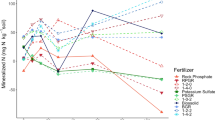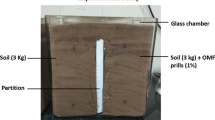Abstract
Organic acids produced by soil microorganisms can be useful to promote the release of potassium (K) from potassium mineral rocks (KR), but the complexity of low reactivity minerals limits K solubilization and their use as fertilizer. Here, we investigate the ways that different organic acids (gluconic, oxalic, and citric) can affect the solubilization of potassium minerals, in order to propose process strategies to improve their solubility. For this, evaluations were performed using the model minerals KRpolyhalite (sedimentary mineral), KRfeldspar (igneous mineral), and KCl (commercial fertilizer). For KCl and KRpolyhalite, complete solubilization was achieved using all the organic acids, while for KRfeldspar, the highest K+ solubilization (34.86 mg L−1) was achieved with oxalic acid. The solubility of KRfeldspar was further investigated under submerged cultivation with the filamentous fungus Aspergillus niger, as well as after a mechanochemical grinding treatment. The biotechnological route resulted in solubilized K up to 63.2 mg L−1. The mechanochemical route, on the other hand, increased the release of K by about 8.6 times (993 mg L−1) compared to the natural mineral, due to the greater fragmentation of the particles after the treatment (with a surface area about 2.5 times higher than for the in natura KRfeldspar). These findings demonstrated the potential of applying biotechnological and mechanochemical routes with organic acids to improve the solubilization of K present in low reactivity mineral rocks, indicating the possible use of these minerals in more sustainable agricultural practices.





Similar content being viewed by others
Data Availability
Data will be available upon request.
Code Availability
Not applicable.
References
Matias, P. C., Mattiello, E. M., Santos, W. O., Badel, J. L., & Alvarez, V. V. H. (2019). Solubilization of a K-silicate rock by Acidithiobacillus thiooxidans. Minerals Engineering, 132(July 2018), 69–75. https://doi.org/10.1016/j.mineng.2018.11.050
Xue, X., Zhang, L., Peng, Y., Li, P., & Yu, J. (2018). Effects of mineral structure and microenvironment on K release from potassium aluminosilicate minerals by Cenococcum geophilum fr. Geomicrobiology Journal, 36(1), 11–18.
Mendes, G. D. O., Luiz, A., & Freitas, M. D. (2014). Mechanisms of phosphate solubilization by fungal isolates when exposed to different P sources. Annales de Microbiologie, 64, 239–249. https://doi.org/10.1007/s13213-013-0656-3
Meena, V. S., Maurya, B. R., & Verma, J. P. (2014). Does a rhizospheric microorganism enhance K+ availability in agricultural soils? Microbiological Research, 169(5–6), 337–347. https://doi.org/10.1016/j.micres.2013.09.003
Masood, S., and Bano, A. (2016). in Potassium Solubilizing Microorganisms for Sustainable Agriculture: Mechanism of potassium solubilization in the agricultural soils by the help of soil microorganism (Meena V., Maurya B., Verma J., Meena R., eds.), Springer, Nova Delhi, pp. 137–147. https://doi.org/10.1007/978-81-322-2776-2_10
Vassilev, N., Mendes, G., Costa, M., & Vassileva, M. (2014). Biotechnological tools for enhancing microbial solubilization of insoluble inorganic phosphates. Geomicrobiology Journal, 31(9), 751–763. https://doi.org/10.1080/01490451.2013.822615
Bakhshandeh, E., Pirdashti, H., & Lendeh, K. S. (2017). Phosphate and potassium-solubilizing bacteria effect on the growth of rice. Ecological Engineering, 103, 164–169. https://doi.org/10.1016/j.ecoleng.2017.03.008
Sattar, A., Naveed, M., Ali, M., Zahir, Z. A., Nadeem, S. M., Yaseen, M., & Meena, H. N. (2019). Perspectives of potassium solubilizing microbes in sustainable food production system a review. Applied Soil Ecology, 133(October 018), 146–159. https://doi.org/10.1016/j.apsoil.2018.09.012
Klaic, R., Plotegher, F., Ribeiro, C., Zangirolami, T. C. C., & Farinas, C. S. S. (2017). A novel combined mechanical-biological approach to improve rock phosphate solubilization. International Journal of Mineral Processing, 161, 50–58. https://doi.org/10.1016/j.minpro.2017.02.009
Klaic, R., Plotegher, F., Ribeiro, C., Zangirolami, T. C., & Farinas, C. S. (2018). A fed-batch strategy integrated with mechanical activation improves the solubilization of phosphate rock by Aspergillus niger. ACS Sustain. Chem. Eng., 6(9), 11326–11334. https://doi.org/10.1021/acssuschemeng.8b00885
Baláž, P. (2003). Mechanical activation in hydrometallurgy. International Journal of Mineral Processing, 72(1–4), 341–354. https://doi.org/10.1016/S0301-7516(03)00109-1
Skorina, T., & Allanore, A. (2015). Aqueous alteration of potassium-bearing aluminosilicate minerals: From mechanism to processing. Green Chemistry, 17(4), 2123–2136. https://doi.org/10.1039/c4gc02084g
Shanware, A. S., Kalkar, S. A., & Trivedi, M. M. (2014). Potassium solublisers : Occurrence, mechanism and their role as competent biofertilizers. Int. J. Curr. Microbiol. Appl. Sci., 3(9), 622–629.
Meena, V. S., Bahadur, I., Maurya, B. R., Kumar, A., Meena, R. K., Meena, S. K., and Verma, J. P. (2016). in Potassium Solubilizing Microorganisms for Sustainable Agriculture: Potassium-solubilizing microorganisms in Evergreen Agriculture: an overview (Meena V., Maurya B., Verma J., Meena R., eds.), Springer, Nova Delhi, pp. 1–20. https://doi.org/10.1007/978-81-322-2776-2_10
Jaiswal D.K., Verma J.P., Prakash S., Meena V.S., Meena R.S. (2016). in Potassium Solubilizing Microorganisms for Sustainable Agriculture: Potassium as an Important Plant Nutrient in Sustainable Agriculture: A State of the Art (Meena V., Maurya B., Verma J., Meena R., eds.), Springer, Nova Delhi, pp. 21–29. https://doi.org/10.1007/978-81-322-2776-2_2
Basak, B. B., Sarkar, B., Biswas, D. R., Sarkar, S., Sanderson, P., and Naidu, R. (2017). in Advances Agronomy, vol. 141: Bio-intervention of naturally occurring silicate minerals for alternative source of potassium: challenges and opportunities (Sparks, D. L., ed.), Academic Press Burlington, pp.115-145. https://doi.org/10.1016/bs.agron.2016.10.016
Stamford, N. P., Andrade, I. P., da Silva, S., Lira Junior, M. A., de Rosália e Silva Santos, C. E., Santiago de Freitas, A. D., and van Straaten, P. (2011). Nutrient uptake by grape in a Brazilian soil affected by rock biofertilizer.J. Soil Sci. Plant Nutr., 11(4), 79–88https://doi.org/10.4067/S0718-95162011000400006
Zörb, C., Senbayram, M., & Peiter, E. (2014). Potassium in agriculture - status and perspectives. Journal of Plant Physiology, 171(9), 656–669. https://doi.org/10.1016/j.jplph.2013.08.008
Basak B.B., Sarkar B. (2017). in Adaptive Soil Management: From Theory to Practices: Scope of Natural Sources of Potassium in Sustainable Agriculture (Rakshit A., Abhilash P., Singh H., Ghosh S., eds.). Springer, Singapore, pp. 247-259. https://doi.org/10.1007/978-981-10-3638-5_12
Singh, B., Cattle, S. R., & Field, D. J. (2014). Edaphic Soil Science Introduction to. Encycl Agric Food Syst, 3(4), 35–58. https://doi.org/10.1016/B978-0-444-52512-3.00092-9
Basak, B.B., Sarkar, B. & Naidu, R. (2021). Environmentally safe release of plant available potassium and micronutrients from organically amended rock mineral powder. Environ Geochem Health 43, 3273–3286. https://doi.org/10.1007/s10653-020-00677-1
Boldrin, K. V. F., de Paiva, P. D. O., Boldrin, P. F., FurtiniNeto, A. E., & Almeida, B. R. (2019). Alternative sources of potassium in the growth of calla lily. Sci. Hortic. (Amsterdam), 255(June 018), 96–102. https://doi.org/10.1016/j.scienta.2019.04.008
Bortoletto-Santos, R., Ribeiro, C., & Polito, W. L. (2016). Controlled release of nitrogen-source fertilizers by natural-oil-based poly(urethane) coatings: The kinetic aspects of urea release. Journal of Applied Polymer Science, 133(33), 1–8. https://doi.org/10.1002/app.43790
Aleksandrov, V. G., Blagodyr, R. N., & Il’ev, I. P. (1967). Phosphorus acid isolation from apatite produced by silicate bacteria. Mikrobiologicheskii Zhurnal, 29(2), 111–114.
Pati, S., Sarkar, T., Sheikh, H. I., Bharadwaj, K. K., Mohapatra, P. K., Chatterji, A., & Nelson, B. R. (2021). γ-irradiated chitosan from Carcinoscorpius rotundicauda (Latreille, 1802) improves the shelf life of refrigerated aquatic products. Frontiers in Marine Science, 8(May), 1–12. https://doi.org/10.3389/fmars.2021.664961
Xu, H., Guo, X., & Bai, J. (2017). Thermal behavior of polyhalite: A high-temperature synchrotron XRD study. Physics and Chemistry of Minerals, 44(2), 125–135. https://doi.org/10.1007/s00269-016-0842-5
Pati, S., Chatterji, A., Dash, B. P., Nelson, B. R., Sarkar, T., Shahimi, S., & Acharya, D. (2020). Structural characterization and antioxidant potential of chitosan by γ-irradiation from the carapace of horseshoe crab. Polymers (Basel), 12(10), 1–14. https://doi.org/10.3390/polym12102361
Huang, P. M., & Wang, M. K. (2005). Minerals Primary In. Encycl Soils Environ, 4, 500–510.
Bindi, L. (2005). Reinvestigation of polyhalite, K2Ca2Mg(SO 4)4·2H2O. Acta Crystallogr Sect E Struct Reports Online, 61(8), 135–136. https://doi.org/10.1107/S1600536805020507
Schlatti, M., Sahl, K., Zemann, A., & Zemann, J. (1970). Die Kristallstruktur des Polyhalits K2Ca2Mg[SO4]42H2O. TMPM Tschermaks Mineral und Petrogr Mitteilungen, 14(2), 75–86. https://doi.org/10.1007/BF01157309
Yadav B.K., Sidhu A.S. (2016). in Potassium Solubilizing Microorganisms for Sustainable Agriculture: Dynamics of Potassium and Their Bioavailability for Plant Nutrition (Meena V., Maurya B., Verma J., Meena R., eds.), Springer, Nova Delhi, pp. 187-201. https://doi.org/10.1007/978-81-322-2776-2_14
Finch, H. J. S., Samuel, A. M., & Lane, G. P. F. (2014). in Lockhart & Wiseman’s Crop Husbandry Including Grassland, 9th ed: Fertilisers and manures (Finch, H. J. S., Samuel, A. M., Lane, G. P. F., eds.), Woodhead Publishing, Sawston, pp. 63–91. https://doi.org/10.1533/9781782423928.1.63
Yermiyahu, U., Zipori, I., Faingold, I., Yusopov, L., Faust, N., & Bar-Tal, A. (2017). Polyhalite as a multi nutrient fertilizer-potassium, magnesium, calcium and sulfate. Isr. J. Plant Sci., 64(3–4), 145–157. https://doi.org/10.1163/22238980-06401001
Bruice, P. (2006). Organic Chemistry. Org. Chem. 5th (5th ed.). Pearson Education Inc. publishing as Prentice Hall.
de Mendes, G., Murta, H. M., Valadares, R. V., da Silveira, W. B., da Silva, I. R., & Costa, M. D. (2020). Oxalic acid is more efficient than sulfuric acid for rock phosphate solubilization. Minerals Engineering, 155(May), 106458. https://doi.org/10.1016/j.mineng.2020.106458
Lide, D. R. (2004). CRC Handbook of Chemistry and Physics, 84th ed., CRC Press, Boca Raton.
Velizarov, S., & Beschkov, V. (1998). Biotransformation of glucose to free gluconic acid by Gluconobacter oxydans: Substrate and product inhibition situations. Process Biochemistry, 33(5), 527–534. https://doi.org/10.1016/S0032-9592(98)00000-4
Ramos-Padrón, E., Bordenave, S., Lin, S., Bhaskar, I. M., Dong, X., Sensen, C. W., & Gieg, L. M. (2011). Carbon and sulfur cycling by microbial communities in a gypsum-treated oil sands tailings pond. Environmental Science and Technology, 45(2), 439–446. https://doi.org/10.1021/es1028487
Hannig, C., Hamkens, A., Becker, K., Attin, R., & Attin, T. (2005). Erosive effects of different acids on bovine enamel : Release of calcium and phosphate in vitro. Archives of Oral Biology, 50, 541–552. https://doi.org/10.1016/j.archoralbio.2004.11.002
Lodi, L. A., Klaic, R., Ribeiro, C., & Farinas, C. S. (2021). A green K-fertilizer using mechanical activation to improve the solubilization of a low-reactivity potassium mineral by Aspergillus niger. Bioresour. Technol. Reports, 15(March), 100711. https://doi.org/10.1016/j.biteb.2021.100711
Yang, L., Lübeck, M., & Lübeck, P. S. (2017). Aspergillus as a versatile cell factory for organic acid production. Fungal Biology Reviews, 31(1), 33–49. https://doi.org/10.1016/j.fbr.2016.11.001
Lian, B., Wang, B., Pan, M., Liu, C., & Teng, H. H. (2008). Microbial release of potassium from K-bearing minerals by thermophilic fungus Aspergillus fumigatus. Geochimica et Cosmochimica Acta, 72(1), 87–98. https://doi.org/10.1016/j.gca.2007.10.005
Sauer, M., Porro, D., Mattanovich, D., & Branduardi, P. (2008). Microbial production of organic acids: Expanding the markets. Trends in Biotechnology, 26(2), 100–108. https://doi.org/10.1016/j.tibtech.2007.11.006
Singh, Y. P., Tanvar, H., Kumar, G., & Dhawan, N. (2019). Investigation of planetary ball milling of sericite for potash recovery. Powder Technology, 351, 115–121. https://doi.org/10.1016/j.powtec.2019.04.013
Acknowledgements
The authors are grateful to the Agronano Network (Embrapa Research Network), the Agroenergy Laboratory, and the National Nanotechnology Laboratory for Agribusiness (LNNA) for the provision of institutional support and facilities. The graphical schemes are from Servier Medical Art (https://smart.servier.com), licensed under the Creative Commons Attribution 3.0 Unported License Agreement (https://creativecommons.org/licenses/by/3.0/).
Funding
Financial support for this work was provided by Coordenação de Aperfeiçoamento de Pessoal de Nível Superior (CAPES, Finance Code 001, grant #88887.360866/2019–00), Fundação de Amparo à Pesquisa do Estado de São Paulo (FAPESP, grants #2016/10.636–8 and #2020/03259–9), and Conselho Nacional de Desenvolvimento Científico e Tecnológico (CNPq, grant #130491/2019–5).
Author information
Authors and Affiliations
Contributions
Ludimila A. Lodi: writing—review and editing; conceptualization; methodology; data curation; formal analysis; investigation; roles/writing—original draft. Rodrigo Klaic: writing—review and editing; conceptualization; data curation; formal analysis; roles/writing—original draft. Ricardo Bortoletto-Santos: writing—review and editing; formal analysis; roles/writing—original draft. Caue Ribeiro: writing—review and editing; funding acquisition; supervision. Cristiane S. Farinas: writing—review and editing; conceptualization; funding acquisition; supervision.
Corresponding author
Ethics declarations
Competing Interests
The authors declare no competing interests.
Additional information
Publisher's Note
Springer Nature remains neutral with regard to jurisdictional claims in published maps and institutional affiliations.
Supplementary Information
Below is the link to the electronic supplementary material.
Rights and permissions
About this article
Cite this article
Lodi, L.A., Klaic, R., Bortoletto-Santos, R. et al. Unveiling the Solubilization of Potassium Mineral Rocks in Organic Acids for Application as K-Fertilizer. Appl Biochem Biotechnol 194, 2431–2447 (2022). https://doi.org/10.1007/s12010-022-03826-7
Received:
Accepted:
Published:
Issue Date:
DOI: https://doi.org/10.1007/s12010-022-03826-7




